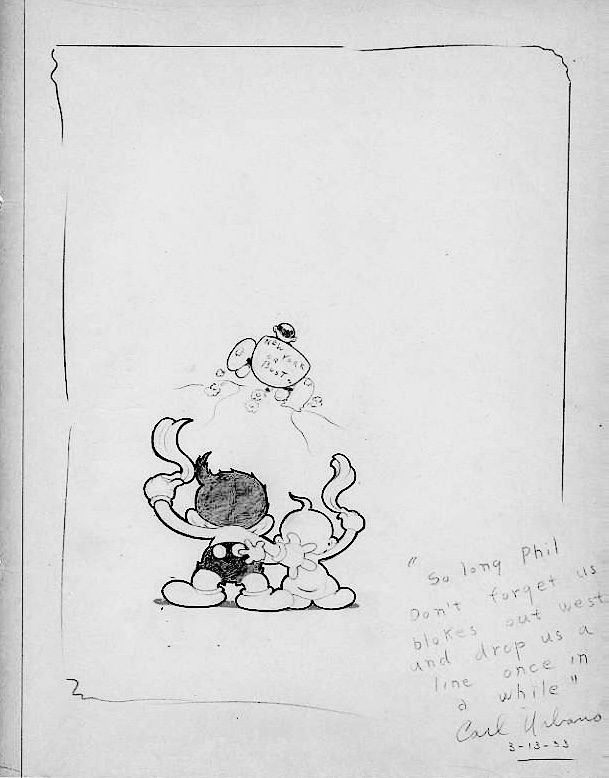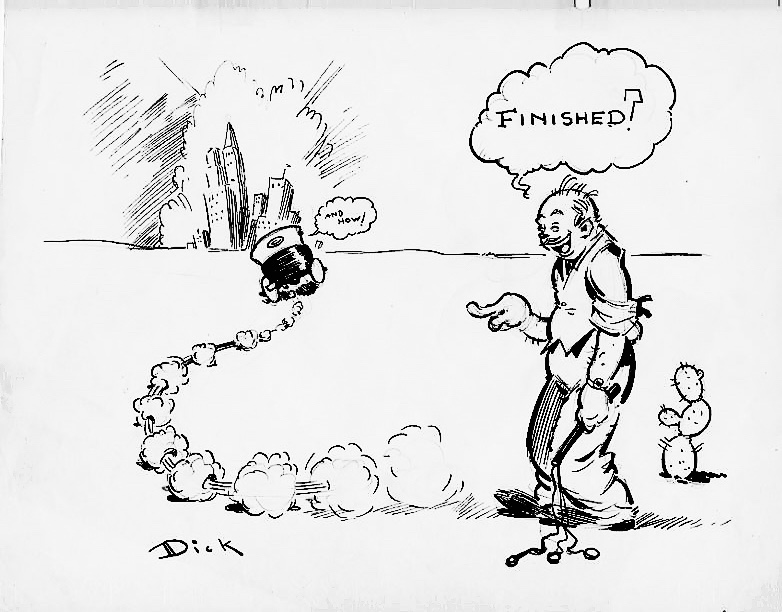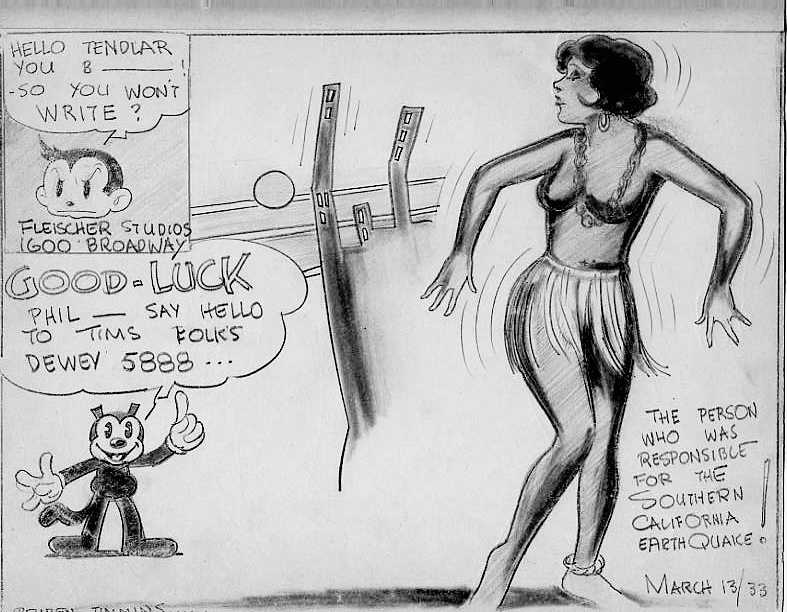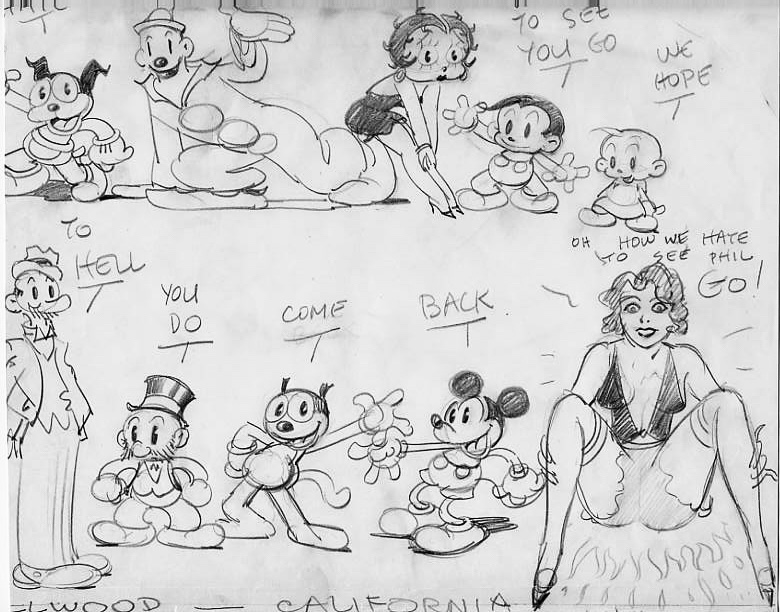Samuel and Rose Davidavitch of Yonkers, New York had four sons who went into the animation business–all after changing the family name to Davis. There was Art, who–at least here at Scrappyland–is best remembered as part of the Mintz brain trust that gave us Scrappy. (His later work as a director and animator at Warner Bros. has its fans, too.) There was Mannie, who stayed in New York and was a key Terrytoons employee for decades. There was Sid, who was also known as Butch and worked alongside Art at Mintz after it became Screen Gems. And there was Phil, who also worked with Art at Mintz/Screen Gems.
Except that in March 1933, Phil left the studio and returned to New York. A few years later, he’d come back and head the Screen Gems in-between department. But his coworkers didn’t know that Phil would be back when they filled a scrapbook with drawings wishing him well as he departed. (Many of them were also New Yorkers who’d headed west–and in some cases would themselves go back and continue their animation careers on the east coast.)
Over at Patreon, Devon Baxter–whose presence there is a must for cartoon fans–has posted dozens of these drawings, courtesy of Art Davis’s granddaughter Sharon Davis and her husband, Steve Marshall. They’re a remarkable collection of work by people who were major figures in the animation industry long after Scrappy left the stage.
Like all good behind-the-scenes gag sketches, these ones are full of in jokes, some of which we probably don’t get. (I do believe that the references to pool in several of them involve the fact that there was a pool hall on the ground floor of the studio’s building.) They feature studio characters diverging from their on-screen behavior, are occasionally racy, and sure look like the people who drew them were having fun. (A few of them even contributed more than one piece.)
You should head to Patreon to see all the drawings–but Devon generously allowed me to share a few here. Naturally, I picked those most closely related to Scrappy.
First of all, here’s Dick Huemer himself, with a fine drawing (given that Scrappy isn’t in it, at least). That’s a self-caricature of Dick–himself a New York transplant–in the foreground. I imagine the whip references his supervisory capacity at the Mintz studio. Within a few weeks, he was at Disney, having left Scrappy and Mintz behind for the studio that would occupy most of this time for the rest of his career.
This one does show Scrappy and Oopy bidding Phil farewell. It’s by Carl Urbano, whom I didn’t realize worked at the Mintz studio. He later directed industrial cartoons for John Sutherland and eventually ended up at Hanna-Barbera before dying in 2003–relatively recently for a Scrappy artist.

Here’s another Scrappy drawing by Marshall Dunning, who worked at Columbia and Disney–but spent most of his career as a political cartoonist. This sketch references WWI, which Dunning served in–and maybe Phil Davis, too, since he would have been old enough.
Reuben Timmins had a long career in animation spanning both coasts and lots of studios, from Fleischer to Filmation. He crammed a lot into his farewell drawing for Phil Davis, starting with a hula girl causing an earthquake–surely the Long Beach one which had occurred the previous week and caused about 115 fatalities. Also in the drawing is Scrappy with a random message for Fleischer animator Dave Tendlar, whom I’m guessing had fallen out of touch with his former colleague Timmins; and Krazy Kat seemingly encouraging Phil to look up Reuben’s relatives in NYC (“Dewey 5888” would have been their phone number).
Lastly from Phil’s Scrappy-book, here’s an amazing drawing with Bimbo, Koko, Betty Boop, Scrappy, Oopy, Mutt, Jeff, Krazy Kat, Mickey Mouse, and a dame whom apparently enjoyed Phil’s company during his time in California. Devon and I am not sure who did this. It’s tempting to wonder if it’s someone who worked on all these characters, but I’m not sure if anyone had in 1933. (Dick Huemer had worked on Mutt and Jeff cartoons and spent time at Fleischer–and left Mintz later in 1933 for Disney–but was gone from Fleischer before Betty Boop arrived.) Perhaps one of you knows who might have done this–Don Yowp’s list of Mintz staffers from 1933 could provide a clue.
[Update: Devon now says: “I’ve talked it over with some trusted experts, and we believe it’s the work of Rudy Zamora. To borrow an observation from Mark Newgarden: ‘The handwriting is a reasonable match with his signature here [on this Fleischer Christmas card]. The way he handles hands & feet & line strokes all check.'”
Bonus material: This Mintz studio gag drawing isn’t from Phil Davis’s scrapbook–it was recently auctioned off by Howard Lowery. It’s by Preston Blair and features caricatures of himself and a “Joe” whom the Lowery listing says is Mintz composer Joe De Nat. I have no reason to doubt that identication, but will note that it’s not readily identifiable as De Nat based on the photos I’ve seen of him. I’m not sure about the precise meaning of the “The March of Time” caption, but it’s presumably a reference to either the radio show (which started in 1931) or the more famous newsreels (which debuted in 1935), both of which were spinoffs from TIME magazine.





